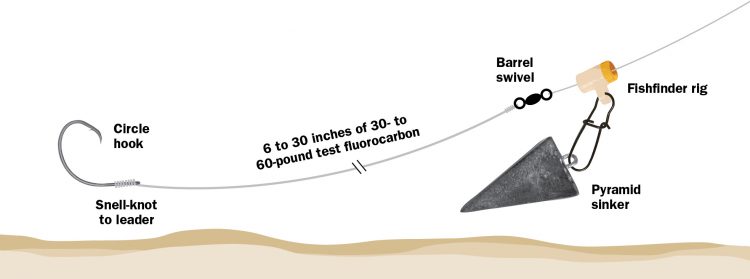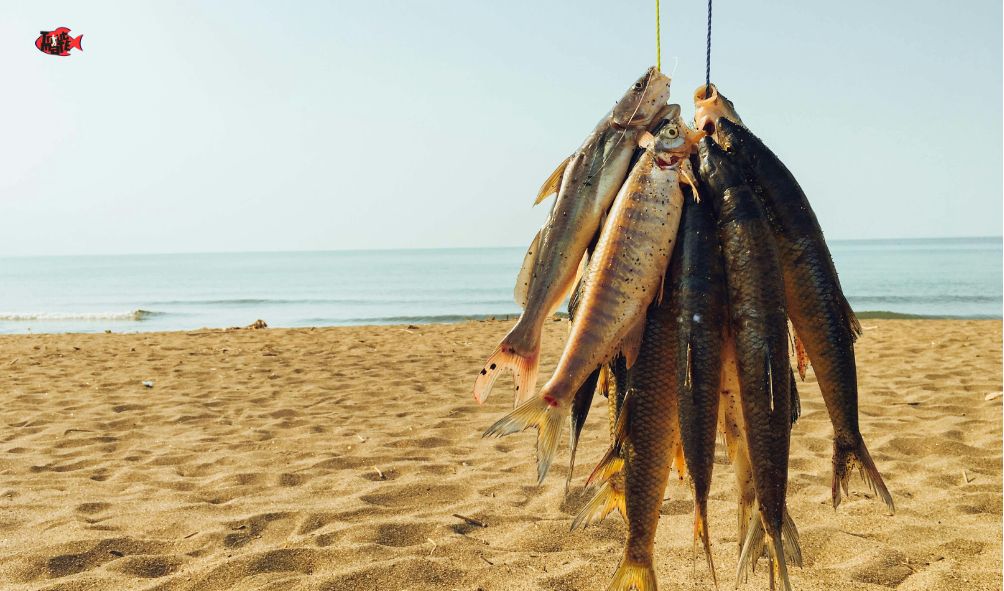To rig for saltwater shore fishing, use a sturdy rod and reel with a high-capacity line. Attach a sinker, swivel, and appropriate hook.
Saltwater shore fishing requires specific gear and techniques to be successful. Anglers need a robust rod and reel to withstand the harsh conditions. A high-capacity line ensures you can handle larger fish. The rigging process involves attaching a sinker to help cast further and reach deeper waters.
A swivel prevents line twists, and choosing the right hook depends on the target species. Bait selection is crucial, with live bait often yielding better results. Proper rigging increases your chances of a successful catch, making your shore fishing experience enjoyable and productive.
Essential Gear
Saltwater shore fishing offers endless excitement and opportunities. Using the right gear increases your success. This section discusses the essential gear needed for a productive fishing experience.
Rods And Reels
Your choice of rods and reels is crucial. Choose a rod that matches the fish species. A medium-heavy rod is versatile for most shore fishing. Ensure the rod length fits your casting needs. For reels, opt for a spinning reel with a high drag capacity. This allows better control over larger fish.
Lines And Leaders
The type of fishing line affects your success rate. Use a braided line for its strength and sensitivity. It helps feel bites and set the hook efficiently. Pair your line with a suitable leader. Fluorocarbon leaders offer stealth and abrasion resistance. Match the leader strength to the target species.
| Gear Component | Recommendation |
|---|---|
| Rod | Medium-Heavy, 7-9 feet |
| Reel | Spinning reel, high drag capacity |
| Line | Braided line, 20-50 lb test |
| Leader | Fluorocarbon, 15-30 lb test |
- Rod: Choose a length that suits your casting distance.
- Reel: Ensure it has a smooth drag system.
- Line: Braided line offers strength and sensitivity.
- Leader: Use fluorocarbon for its invisibility and toughness.

Credit: www.reddit.com
Choosing Baits
Choosing the right bait is key for successful saltwater shore fishing. The right bait attracts the fish you want to catch. Explore live bait and artificial lures options below.
Live Bait Options
Live bait often mimics the natural food source of saltwater fish. Common choices include:
- Shrimp: Effective for a variety of fish like redfish and snappers.
- Sand Fleas: Perfect for catching pompano and other surf fish.
- Squid: Great for bottom feeders like flounder and sea bass.
- Live Minnows: Attracts larger predators such as tarpon and snook.
Make sure to keep your live bait fresh. Use a bait bucket with aeration.
Artificial Lures
Artificial lures can be just as effective as live bait. They are reusable and versatile. Here are some popular types:
- Jigs: Work well in various water conditions.
- Spoons: Mimic small fish and attract fast-moving predators.
- Soft Plastics: Imitate worms, crabs, and shrimp.
- Topwater Lures: Create surface action that attracts aggressive fish.
Choose lures that match the local baitfish in color and size. This increases your chances of a catch.
Rigs For Shore Fishing
Shore fishing in saltwater is an exciting adventure. The right rig can make all the difference. Knowing the best rigs helps you catch more fish. Let’s explore two effective rigs: the Fish Finder Rig and the Carolina Rig.
Fish Finder Rig
The Fish Finder Rig is great for targeting big fish. This rig allows the bait to move naturally. It uses a sliding sinker, which helps detect bites.
| Component | Description |
|---|---|
| Leader | Usually 20-30 inches long |
| Swivel | Connects the leader to the mainline |
| Sinker Slide | Allows the sinker to slide on the mainline |
| Hook | Must match the size of the target fish |
Steps to set up a Fish Finder Rig:
- Attach the sinker slide to the mainline.
- Connect a swivel below the sinker slide.
- Tie the leader to the swivel.
- Attach the hook to the leader.
Carolina Rig
The Carolina Rig is versatile. It works well in saltwater and freshwater. This rig keeps the bait off the bottom, making it more visible to fish.
| Component | Description |
|---|---|
| Leader | Typically 12-24 inches long |
| Swivel | Prevents line twist |
| Bead | Protects the knot from the sinker |
| Egg Sinker | Slides on the mainline |
| Hook | Should be suitable for the bait used |
Steps to set up a Carolina Rig:
- Slide the egg sinker onto the mainline.
- Add a bead below the sinker.
- Tie a swivel below the bead.
- Attach the leader to the swivel.
- Connect the hook to the leader.
Casting Techniques
Casting is crucial for successful saltwater shore fishing. It helps you reach deeper waters where fish are more abundant. Two popular casting techniques are overhead casting and sidearm casting. Both have their advantages and can be mastered with practice.
Overhead Casting
Overhead casting is a straightforward technique that allows for long-distance casts. This method is ideal for anglers who need to cast beyond the breaking waves.
- Stand with your feet shoulder-width apart.
- Hold the rod with both hands, one near the reel and the other at the butt.
- Pull the rod back over your shoulder.
- Swing the rod forward in a smooth motion.
- Release the line when the rod is at eye level.
Make sure to maintain a firm grip on the rod. This ensures better control and accuracy.
Sidearm Casting
Sidearm casting is useful in windy conditions or when you need to cast under obstacles. This technique is less strenuous and allows for quick, short-range casts.
- Stand with your feet slightly apart.
- Hold the rod parallel to the ground.
- Swing the rod sideways, using your dominant hand.
- Release the line when the rod is pointing at your target.
Sidearm casting reduces wind resistance, giving you more control over your cast.
Knot Tying Tips
Mastering the right knots is key to successful saltwater shore fishing. Strong knots ensure your bait stays secure and your catch doesn’t escape. Here are two essential knots every angler should know.
Palomar Knot
The Palomar Knot is simple yet incredibly strong. It’s perfect for tying hooks, lures, and swivels.
- Double about 6 inches of your line and pass it through the eye of your hook.
- Tie a loose overhand knot with the doubled line.
- Pass the loop over the hook.
- Pull on the standing line to tighten the knot.
Ensure the knot is tight and trim the excess line. This knot maintains almost 100% of the line’s strength.
Improved Clinch Knot
The Improved Clinch Knot is reliable and easy to tie. It’s ideal for securing hooks, lures, and swivels.
- Pass the end of the line through the eye of the hook.
- Wrap the line around itself five to seven times.
- Pass the end through the small loop near the eye.
- Pass the end through the big loop.
- Moisten the knot and pull on the tag end to tighten.
This knot is popular because it is strong and easy to tie. Make sure it is snug and cut the extra line.

Credit: www.heyskipperfishing.com
Reading The Water
Understanding how to read the water is vital for successful saltwater shore fishing. It helps you identify the best spots and times for casting your line. Knowing the water conditions can make a significant difference between a fruitful day and an empty bucket.
Tides And Currents
Tides and currents greatly influence fish behavior and movement. Fish are more likely to be active during specific tidal conditions. Here’s a simple breakdown:
| Tide Type | Fish Activity |
|---|---|
| Incoming Tide | Fish move closer to shore to feed. |
| Outgoing Tide | Fish follow the retreating water. |
Currents can also direct fish to certain areas. Fish often swim along currents in search of food. Pay attention to the flow of water. Fish are likely to be where the current is strong but not too turbulent.
Spotting Fish Activity
Observing fish activity can give you clues about where to cast your line. Look for these signs:
- Ripples on the water surface: This could indicate small fish or baitfish.
- Birds diving: Birds often feed on the same fish that larger fish hunt.
- Splashing or jumping fish: This is a clear sign of fish activity.
Using these tips can help you identify the best fishing spots. Always remain observant and adapt to changing conditions.
Safety Measures
Fishing from the shore can be an exhilarating experience. But safety should always be your top priority. Whether you’re a seasoned angler or a beginner, following essential safety measures ensures a fun and accident-free adventure.
Sun Protection
The sun can be harsh and unforgiving, especially near the water. Always wear sunscreen with a high SPF. Reapply it every two hours. Don’t forget to cover your ears and neck.
A wide-brimmed hat offers extra protection. Sunglasses with UV protection shield your eyes from harmful rays. Look for ones that wrap around for full coverage. Wearing light, breathable clothing can help keep you cool.
Hydration is key. Drink plenty of water. Avoid sugary or caffeinated drinks. They can dehydrate you quickly.
Handling Hooks
Hooks are sharp and can cause serious injuries. Use pliers to handle them. Always keep your fingers away from the pointy end.
If a hook gets stuck in your skin, don’t pull it out forcefully. Seek medical attention immediately. A first-aid kit should be part of your fishing gear. Include band-aids, antiseptic wipes, and tweezers.
Keep hooks in a secure container. This prevents accidental injuries. Avoid leaving them lying around. Pets and kids can easily get hurt.
When casting, look around first. Ensure no one is within your casting range. This avoids hooking someone accidentally.
Local Regulations
Understanding local regulations is crucial for saltwater shore fishing. These rules help protect fish populations and ensure sustainable fishing. Before heading out, familiarize yourself with the rules that apply to your area.
Fishing Licenses
Most regions require a fishing license for saltwater shore fishing. This license ensures that anglers contribute to conservation efforts. Check your local government’s website for license requirements. They often offer daily, weekly, or annual options. Always carry your license while fishing.
Catch Limits
Every location has specific catch limits for different fish species. These limits help prevent overfishing and protect the ecosystem. Check the daily bag limits for the area you plan to fish. Here’s an example of how catch limits might be structured:
| Fish Species | Daily Bag Limit | Size Limit |
|---|---|---|
| Red Snapper | 2 per person | 16 inches minimum |
| Flounder | 5 per person | 14 inches minimum |
| Speckled Trout | 10 per person | 15 inches minimum |
Always keep a measuring tape handy to ensure your catch meets size limits. Release any fish that do not meet these requirements. Ignoring these rules can lead to fines and harm the fish population. Keeping within the limits helps preserve the sport for future generations.

Credit: onthewater.com
Frequently Asked Questions
What Is The Best Rig For Ocean Shore Fishing?
The best rig for ocean shore fishing is the fish-finder rig. It includes a sliding sinker and a strong hook. This rig helps detect bites easily and is effective for catching various fish species. Use fresh bait for the best results.
What Is The Best Bait For Saltwater Shore Fishing?
Fresh shrimp, cut bait, and squid are the best baits for saltwater shore fishing. They attract a variety of fish. Live bait like mullet and pinfish also works well. Choose bait based on the fish species you’re targeting.
How To Set Up a Saltwater Fishing Rig?
Attach a suitable saltwater hook to your line. Add a sinker above the hook. Use a leader for added strength. Choose bait like shrimp or squid. Cast and enjoy your fishing.
How Do You Catch Saltwater Fish From The Shore?
Use a sturdy rod and reel, saltwater bait, and strong line. Cast near structures like piers and rocks. Fish during high tide. Wear appropriate gear and be patient.
Mastering saltwater shore fishing rigging techniques can greatly enhance your fishing experience. Use the right gear, knots, and baits to increase your chances of success. Practice makes perfect, so experiment with different setups. Soon, you’ll be well on your way to catching more fish from the shore.
Happy fishing!

